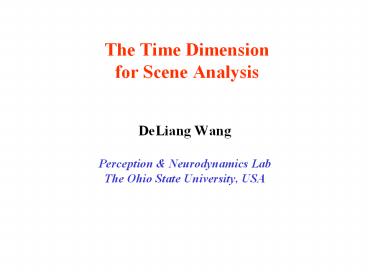The Time Dimension for Scene Analysis - PowerPoint PPT Presentation
1 / 26
Title:
The Time Dimension for Scene Analysis
Description:
The Time Dimension for Scene Analysis DeLiang Wang Perception & Neurodynamics Lab The Ohio State University, USA Presentation outline Introduction Scene analysis and ... – PowerPoint PPT presentation
Number of Views:97
Avg rating:3.0/5.0
Title: The Time Dimension for Scene Analysis
1
The Time Dimension for Scene Analysis
- DeLiang Wang
- Perception Neurodynamics Lab
- The Ohio State University, USA
2
Presentation outline
- Introduction
- Scene analysis and temporal correlation theory
- Oscillatory Correlation
- LEGION network
- Oscillatory Correlation Approach to Scene
Analysis - Image segmentation
- Object selection
- Cocktail party problem
- Concluding remarks
3
Scene analysis problem
4
Binding problem
- Feature binding (integration) is a fundamental
problem in neuroscience and perception (and
perceptrons)
Binding problem in Rosenblatts perceptrons
5
Temporal correlation theory
- Temporal correlation theory proposes a solution
to the nervous integration problem (von der
Malsburg81 also Milnor74) - Application to cocktail party processing (von der
Malsburg Schneider86)
6
Physiological evidence (Gray et al.89)
7
Oscillatory correlation theory
- Oscillators represent feature detectors
- Binding is encoded by synchrony within an
oscillator assembly and desynchrony between
different assemblies
8
Computational requirements
- Need to synchronize locally coupled oscillator
population - Need to desynchronize different populations, when
facing multiple objects - Synchrony and desynchrony
must be achieved rapidly
9
LEGION architecture
- LEGION - Locally Excitatory Globally Inhibitory
Oscillator Network (Terman Wang95)
10
Relaxation oscillator as building block
- With stimulus
Without stimulus
Typical x trace (membrane potential)
11
Analytical results
- Theorem 1. (Synchronization). The oscillators in
a connected block synchronize at an exponential
rate - Theorem 2. (Multiple patterns) If at the
beginning all the oscillators of the same block
synchronize and different blocks desynchronize,
then synchrony within each block and the ordering
of activations among different blocks are
maintained - Theorem 3. (Desynchronization) If at the
beginning all the oscillators of the system lie
not too far away from each other, then the
condition of Theorem 2 will be satisfied after
some time. Moreover, the time it takes to
satisfy the condition is no greater than N
cycles, where N is the number of blocks
12
Connectedness problem
- Minsky-Papert connectedness problem is a
long-standing problem in perceptron learning - The problem exposes fundamental limitations of
supervised learning, and illustrates the
importance of proper representations
13
Connectedness problem LEGION solution
- Basic idea Synchronization within a connected
pattern and desynchronization between different
ones
14
Presentation outline
- Introduction
- Scene analysis and temporal correlation theory
- Oscillatory Correlation
- LEGION network
- Oscillatory Correlation Approach to Scene
Analysis - Image segmentation
- Object selection
- Cocktail party problem
- Concluding remarks
15
Oscillatory correlation approach to scene
segmentation
- Feature extraction first takes place
- An visual feature can be pixel intensity, depth,
local image patch, texture element, optic flow,
etc. - An auditory feature can be a pure tone, amplitude
and frequency modulation, onset, harmonicity,
etc. - Connection weights between neighboring
oscillators are set to be proportional to feature
similarity - Global inhibitor controls granularity of
segmentation - Larger inhibition results in more and smaller
regions - Segments pop out from LEGION in time
16
Image segmentation example Demo
Input image
17
Image segmentation example
Input image
Segmentation result
18
Object selection
- The slow inhibitor keeps trace of each pattern,
which can be overcome by only more salient
(larger) patterns - Unlike traditional winner-take-all dynamics,
selection (competition) takes place at the object
level - Consistent with object-based attention theory
- Binding precedes attention, rather than attention
precedes binding (Treisman Gelade80)
19
Results of object selection
LEGION output
Selection output
Input image
Input LEGION segmentation
Selection
20
Cocktail party problem
- In a natural environment, target speech is
usually corrupted by acoustic interference,
creating a speech segregation problem - Popularly known as cocktail-party problem
(Cherry53) also ball-room problem (Helmholtz,
1863) - Human listeners organize sound in a perceptual
process called auditory scene analysis
(Bregman90) - Auditory scene analysis (ASA) takes place in two
conceptual stages - Segmentation. Decompose the acoustic signal into
sensory elements (segments) - Grouping. Combine segments into groups, so that
segments in the same group likely originate from
the same sound source
21
Oscillatory correlation for ASA (Wang Brown99)
Frequency
22
Auditory periphery Cochleagram
- Cochleagram representation of the utterance Why
were you all weary? mixed with phone ringing
23
Grouping layer Example
- Two streams emerge from the group layer
- Foreground left (original mixture
) - Background right
- More recent results (Hu Wang04)
24
Back to physiology
- Chattering cells recorded by Gray McCormick96
- Burst oscillations are best modeled by relaxation
oscillators
25
Versatility and time dimension
- The principle of universality Give me a
concrete problem and I will devise a network that
solves it. (von der Malsburg99) - It characterizes artificial intelligence
- The principle of versatility Given the network,
learn to cope with situations and problems as
they arise. (von der Malsburg99) - It characterizes natural intelligence
- Time dimension is necessary for versatility
- Flexible and infinitely extensible
- Irreplaceable by spatial organization
26
Conclusion
- Advances in dynamical analysis overcome
computational obstacles of oscillatory
correlation theory - Major progress is made towards solving the scene
analysis problem - From Hebbs cell assemblies to von der Malsburgs
correlation theory, time is an indispensable
dimension for scene analysis































